Aerosol Physical–Optical Properties under Different Stages of Continuous Wet Weather over the Guangdong–Hong Kong–Macao Greater Bay Area, China
Abstract
1. Introduction
2. Materials and Methods
2.1. Study Area and Methods
2.2. Reanalysis Data
2.3. Satellite Data
- (1)
- Extinction quality control (QC) is equal to 0 or 1.
- (2)
- −100 ≤ CAD score ≤ −50.
- (3)
- Extinction Coefficient Uncertainty ≤10.
- (4)
- Atmospheric Volume Description is equal to 3.
- (5)
- Extinction_Coefficient_532 is not equal to −9999.
3. Results
3.1. Changes in Meteorological Parameters
3.2. Variation in Aerosol Optical Properties
3.3. Optical Thickness and Proportion of Different Aerosol Types
3.4. Case Study
4. Conclusions
Author Contributions
Funding
Data Availability Statement
Acknowledgments
Conflicts of Interest
References
- Chen, J.; Xin, J.; An, J.; Wang, Y.; Liu, Z.; Chao, N.; Meng, Z. Observation of aerosol optical properties and particulate pollution at background station in the Pearl River Delta region. Atmos. Res. 2014, 143, 216–227. [Google Scholar] [CrossRef]
- Zhang, H.Y.; Lu, K.D. Impact of Typical Meteorological Conditions on the O3 and PM10 Pollution Episodes in the Pearl River Delta in Autumn. Acta Sci. Nat. Univ. Pekin. 2014, 50, 565–576. [Google Scholar]
- Li, Z.; Xia, X.; Cribb, M.; Mi, W.; Holben, B.; Wang, P.; Chen, H.; Tsay, S.-C.; Eck, T.F.; Zhao, F.; et al. Aerosol optical properties and their radiative effects in northern China. J. Geophys. Res. Atmos. 2007, 112, D22S01. [Google Scholar] [CrossRef]
- Zhou, Y.; Shan, Y.; Liu, G.; Guan, D. Emissions and low-carbon development in Guangdong-Hong Kong-Macao Greater Bay Area cities and their surroundings. Appl. Energy 2018, 228, 1683–1692. [Google Scholar] [CrossRef]
- Charlson, R.J.; Schwartz, S.E.; Hales, J.M.; Cess, R.D.; Coakley, J.A., Jr.; Hansen, J.E.; Hofmann, D.J. Climate Forcing by Anthropogenic Aerosols. Science 1992, 255, 423–430. [Google Scholar] [CrossRef]
- Luo, H.; Han, Y.; Lu, C.; Yang, J.; Wu, Y. Characteristics of Surface Solar Radiation under Different Air Pollution Conditions over Nanjing, China: Observation and Simulation. Adv. Atmos. Sci. 2019, 36, 1047–1059. [Google Scholar] [CrossRef]
- Ningombam, S.S.; Bagare, S.P.; Khatri, P.; Sohn, B.J.; Song, H.J. Estimation of aerosol radiative forcing over an aged-background aerosol feature during advection and non-advection events using a ground-based data obtained from a Prede Skyradiometer observation. Atmos. Res. 2015, 164–165, 76–83. [Google Scholar] [CrossRef]
- Eck, T.F.; Holben, B.N.; Reid, J.S.; Giles, D.M.; Rivas, M.A.; Singh, R.P.; Tripathi, S.N.; Bruegge, C.J.; Platnick, S.; Arnold, G.T.; et al. Fog- and cloud-induced aerosol modification observed by the Aerosol Robotic Network (AERONET). J. Geophys. Res. Atmos. 2012, 117, D07206. [Google Scholar] [CrossRef]
- Li, Z.; Niu, F.; Fan, J.; Liu, Y.; Rosenfeld, D.; Ding, Y. Long-term impacts of aerosols on the vertical development of clouds and precipitation. Nat. Geosci. 2011, 4, 888–894. [Google Scholar] [CrossRef]
- Luo, H.; Han, Y. Impacts of the Saharan air layer on the physical properties of the Atlantic tropical cyclone cloud systems: 2003–2019. Atmos. Chem. Phys. 2021, 21, 15171–15184. [Google Scholar] [CrossRef]
- Twomey, S. The Influence of Pollution on the Shortwave Albedo of Clouds. J. Atmos. Sci. 1977, 34, 1149–1152. [Google Scholar] [CrossRef]
- Hansen, J.; Sato, M.; Ruedy, R.; Lacis, A.; Oinas, V. Global warming in the twenty-first century: An alternative scenario. Proc. Natl. Acad. Sci. USA 2000, 97, 9875–9880. [Google Scholar] [CrossRef]
- Luo, Y.; Zheng, X.; Zhao, T.; Chen, J. A climatology of aerosol optical depth over China from recent 10 years of MODIS remote sensing data. Int. J. Climatol. 2014, 34, 863–870. [Google Scholar] [CrossRef]
- Li, L.; Che, H.; Derimian, Y.; Dubovik, O.; Luan, Q.; Li, Q.; Huang, X.; Zhao, H.; Gui, K.; Zheng, Y.; et al. Climatology of Fine and Coarse Mode Aerosol Optical Thickness over East and South Asia Derived from POLDER/PARASOL Satellite. J. Geophys. Res. Atmos. 2020, 125, e2020JD032665. [Google Scholar] [CrossRef]
- Dasarathy, S.; Kar, J.; Tackett, J.; Rodier, S.D.; Lu, X.; Vaughan, M.; Toth, T.D.; Trepte, C.; Bowman, J.S. Multi-Year Seasonal Trends in Sea Ice, Chlorophyll Concentration, and Marine Aerosol Optical Depth in the Bellingshausen Sea. J. Geophys. Res. Atmos. 2021, 126, e2021JD034737. [Google Scholar] [CrossRef]
- He, J.; Zha, Y.; Zhang, J.; Gao, J. Aerosol Indices Derived from MODIS Data for Indicating Aerosol-Induced Air Pollution. Remote Sens. 2014, 6, 1587–1604. [Google Scholar] [CrossRef]
- Luna, M.A.G.; Luna, F.A.G.; Espinosa, J.F.M.; Belalcazar-Cer’on, L.C. Spatial and temporal assessment of particulate matter using AOD data from MODIS and surface measurements in the ambient air of Colombia. Asian J. Atmos. Environ. 2018, 12, 165–177. [Google Scholar] [CrossRef]
- Lin, C.; Labzovskii, L.D.; Mak, H.W.L.; Fung, J.C.H.; Lau, A.K.H.; Kenea, S.T.; Bilal, M.; Hey, J.D.V.; Lu, X.; Ma, J. Observation of PM2.5 Using a Combination of Satellite Remote Sensing and Low-Cost Sensor Network in Siberian Urban Areas with Limited Reference Monitoring. Atmos. Environ. 2020, 227, 117410. [Google Scholar] [CrossRef]
- Handschuh, J.; Erbertseder, T.; Schaap, M.; Baier, F. Estimating PM2.5 surface concentrations from AOD: A combination of SLSTR and MODIS. Remote Sens. Appl. Soc. Environ. 2022, 26, 100716. [Google Scholar] [CrossRef]
- Itahashi, S.; Sakurai, T.; Shimadera, H.; Araki, S.; Hayami, H. Long-term trends of satellite-based fine-mode aerosol optical depth over the Seto Inland Sea, Japan, over two decades (2001–2020). Environ. Res. Lett. 2021, 16, 064062. [Google Scholar] [CrossRef]
- Sotoudeheian, S.; Arhami, M. Estimating ground-level PM2.5 concentrations by developing and optimizing machine learning and statistical models using 3 km MODIS AODs: Case study of Tehran, Iran. J. Environ. Health Sci. Eng. 2021, 19, 1–21. [Google Scholar] [CrossRef]
- Li, L.; Che, H.; Zhang, X.; Chen, C.; Chen, X.; Gui, K.; Liang, Y.; Wang, F.; Derimian, Y.; Fuertes, D.; et al. A satellite-measured view of aerosol component content and optical property in a haze-polluted case over North China Plain. Atmos. Res. 2022, 266, 105958. [Google Scholar] [CrossRef]
- Che, H.; Xia, X.; Zhu, J.; Li, Z.; Dubovik, O.; Holben, B.; Goloub, P.; Chen, H.; Estelles, V.; Cuevas-Agulló, E.; et al. Column aerosol optical properties and aerosol radiative forcing during a serious haze-fog month over North China Plain in 2013 based on ground-based sunphotometer measurements. Atmos. Chem. Phys. 2014, 14, 2125–2138. [Google Scholar] [CrossRef]
- Holben, B.N.; Tanré, D.; Smirnov, A.; Eck, T.F.; Slutsker, I.; Abuhassan, N.; Newcomb, W.W.; Schafer, J.S.; Chatenet, B.; Lavenu, F.; et al. An emerging ground-based aerosol climatology: Aerosol optical depth from AERONET. J. Geophys. Res. Atmos. 2001, 106, 12067–12097. [Google Scholar] [CrossRef]
- Che, H.; Zhang, X.; Chen, H.; Damiri, B.; Goloub, P.; Li, Z.; Zhang, X.; Wei, Y.; Zhou, H.; Dong, F.; et al. Instrument calibration and aerosol optical depth validation of the China Aerosol Remote Sensing Network. J. Geophys. Res. Atmos. 2009, 114, D03206. [Google Scholar] [CrossRef]
- Ceamanos, X.; Six, B.; Riedi, J. Quasi-Global Maps of Daily Aerosol Optical Depth from a Ring of Five Geostationary Meteorological Satellites Using AERUS-GEO. J. Geophys. Res. Atmos. 2021, 126, e2021JD034906. [Google Scholar] [CrossRef]
- Li, X.; Zhang, C.; Li, W.; Anyah, R.O.; Tian, J. Exploring the trend, prediction and driving forces of aerosols using satellite and ground data, and implications for climate change mitigation. J. Clean. Prod. 2019, 223, 238–251. [Google Scholar] [CrossRef]
- Kaufman, Y.J.; Tanré, D.; Boucher, O. A satellite view of aerosols in the climate system. Nature 2002, 419, 215–223. [Google Scholar] [CrossRef]
- Huang, J.; Arnott, W.P.; Barnard, J.C.; Holmes, H.A. Theoretical Uncertainty Analysis of Satellite Retrieved Aerosol Optical Depth Associated with Surface Albedo and Aerosol Optical Properties. Remote Sens. 2021, 13, 344. [Google Scholar] [CrossRef]
- Chen, X.; Wang, N.; Wang, G.; Wang, Z.; Chen, H.; Cheng, C.; Li, M.; Zheng, L.; Wu, L.; Zhang, Q.; et al. The Influence of Synoptic Weather Patterns on Spatiotemporal Characteristics of Ozone Pollution across Pearl River Delta of Southern China. J. Geophys. Res. Atmos. 2022, 127, e2022JD037121. [Google Scholar] [CrossRef]
- Huige, D.; Siwen, L.; Yun, Y.; Dengxin, H.; Jianyu, W. Observational study of the vertical aerosol and meteorological factor distributions with respect to particulate pollution in Xi’an. Atmos. Environ. 2021, 247, 118215. [Google Scholar] [CrossRef]
- Hu, W.; Zhao, T.; Bai, Y.; Kong, S.; Shen, L.; Xiong, J.; Zhou, Y.; Gu, Y.; Shi, J.; Zheng, H.; et al. Regulation of Synoptic Circulation in Regional PM2.5 Transport for Heavy Air Pollution: Study of 5-Year Observation over Central China. J. Geophys. Res. Atmos. 2022, 127, e2021JD035937. [Google Scholar] [CrossRef]
- Yang, Y.; Yim, S.H.L.; Haywood, J.; Osborne, M.; Chan, J.C.S.; Zeng, Z.; Cheng, J.C.H. Characteristics of Heavy Particulate Matter Pollution Events Over Hong Kong and Their Relationships With Vertical Wind Profiles Using High-Time-Resolution Doppler Lidar Measurements. J. Geophys. Res. Atmos. 2019, 124, 9609–9623. [Google Scholar] [CrossRef]
- Xu, X.; Xie, J.; Li, Y.; Miao, S.; Fan, S. Measurement report: Vehicle-based multi-lidar observational study of the effect of meteorological elements on the three-dimensional distribution of particles in the western Guangdong–Hong Kong–Macao Greater Bay Area. Atmos. Chem. Phys. 2022, 22, 139–153. [Google Scholar] [CrossRef]
- Liu, Y.; He, J.; Lai, X.; Zhang, C.; Zhang, L.; Gong, S.; Che, H. Influence of Atmospheric Circulation on Aerosol and its Optical Characteristics in the Pearl River Delta Region. Atmosphere 2020, 11, 288. [Google Scholar] [CrossRef]
- Yang, X.; Wu, K.; Lu, Y.; Wang, S.; Qiao, Y.; Zhang, X.; Wang, Y.; Wang, H.; Liu, Z.; Liu, Y.; et al. Origin of regional springtime ozone episodes in the Sichuan Basin, China: Role of synoptic forcing and regional transport. Environ. Pollut. 2021, 278, 116845. [Google Scholar] [CrossRef]
- Zhang, D.; Wang, Y.; Feng, Y. Analysis and Forecasting of High-Humidity Weather in Guangdong in February and March. Meteorol. Sci. Technol. 2014, 42, 302–308. [Google Scholar] [CrossRef]
- Tan, H.; Yin, Y.; Gu, X.; Li, F.; Chan, P.W.; Xu, H.; Deng, X.; Wan, Q. An observational study of the hygroscopic properties of aerosols over the Pearl River Delta region. Atmos. Environ. 2013, 77, 817–826. [Google Scholar] [CrossRef]
- Huang, Z.; Ou, J.; Zheng, J.; Yuan, Z.; Yin, S.; Chen, D.; Tan, H. Process Contributions to Secondary Inorganic Aerosols during Typical Pollution Episodes over the Pearl River Delta Region, China. Aerosol Air Qual. Res. 2016, 16, 2129–2144. [Google Scholar] [CrossRef]
- Bi, M.L.; Xie, G.D.; Yao, C.Y. Regional Policies Targeting Residential Solid Fuel and Agricultural Emissions Can Improve Air Quality and Public Health in the Greater Bay Area and Across China. Ecol. Indic. 2020, 116, 106432. [Google Scholar] [CrossRef]
- Nguyen, J.L.; Schwartz, J.; Dockery, D.W. The relationship between indoor and outdoor temperature, apparent temperature, relative humidity, and absolute humidity. Indoor Air 2014, 24, 103–112. [Google Scholar] [CrossRef]
- Reber, E.E.; Swope, J.R. On the Correlation of the Total Precipitable Water in a Vertical Column and Absolute Humidity at the Surface. J. Appl. Meteorol. 1972, 11, 1322–1325. [Google Scholar] [CrossRef]
- Quan, J.; Tie, X.; Zhang, Q.; Liu, Q.; Li, X.; Gao, Y.; Zhao, D. Characteristics of heavy aerosol pollution during the 2012–2013 winter in Beijing, China. Atmos. Environ. 2014, 88, 83–89. [Google Scholar] [CrossRef]
- Gelaro, R.; McCarty, W.; Suarez, M.J.; Todling, R.; Molod, A.; Takacs, L.; Randles, C.; Darmenov, A.; Bosilovich, M.G.; Reichle, R.; et al. The Modern-Era Retrospective Analysis for Research and Applications, Version 2 (MERRA-2). J. Clim. 2017, 30, 5419–5454. [Google Scholar] [CrossRef]
- Randles, C.A.; Da Silva, A.M.; Buchard, V.; Colarco, P.R.; Darmenov, A.; Govindaraju, R.; Smirnov, A.; Holben, B.; Ferrare, R.; Hair, J.; et al. The MERRA-2 Aerosol Reanalysis, 1980—Onward, Part I: System Description and Data Assimilation Evaluation. J. Clim. 2017, 30, 6823–6850. [Google Scholar] [CrossRef]
- Hersbach, H.; Bell, B.; Berrisford, P.; Hirahara, S.; Horányi, A.; Muñoz-Sabater, J.; Nicolas, J.; Peubey, C.; Radu, R.; Schepers, D.; et al. The ERA5 global reanalysis. Q. J. R. Meteorol. Soc. 2020, 146, 1999–2049. [Google Scholar] [CrossRef]
- Albergel, C.; Dutra, E.; Munier, S.; Calvet, J.-C.; Munoz-Sabater, J.; de Rosnay, P.; Balsamo, G. ERA-5 and ERA-Interim driven ISBA land surface model simulations: Which one performs better? Hydrol. Earth Syst. Sci. 2018, 22, 3515–3532. [Google Scholar] [CrossRef]
- Gleixner, S.; Demissie, T.; Diro, G.T. Did ERA5 Improve Temperature and Precipitation Reanalysis over East Africa? Atmosphere 2020, 11, 996. [Google Scholar] [CrossRef]
- Winker, D.M.; Tackett, J.L.; Getzewich, B.J.; Liu, Z.; Vaughan, M.A.; Rogers, R.R. The global 3-D distribution of tropospheric aerosols as characterized by CALIOP. Atmos. Chem. Phys. 2013, 13, 3345–3361. [Google Scholar] [CrossRef]
- Zhang, Y.; Wei, F.; Luo, H.; Su, Y.; Feng, Y.; Huang, Y.; Yang, J.; Wu, Y.; Han, Y. Aerosol Physical-Optical Properties and PBLH Under Different Air Pollution Levels From Ground Lidar and Satellite Observations Over Shouxian Area, China. J. Geophys. Res. Atmos. 2021, 126, e2021JD035236. [Google Scholar] [CrossRef]
- Lu, X.; Chow, K.-C.; Yao, T.; Fung, J.C.H.; Lau, A.K.H. Seasonal variation of the land-sea breeze circulation in the Pearl River Delta region. J. Geophys. Res. Atmos. 2009, 114, D17112. [Google Scholar] [CrossRef]
- Mai, B.; Deng, X.; Xia, X.; Che, H.; Guo, J.; Liu, X.; Zhu, J.; Ling, C. Column-integrated aerosol optical properties of coarse- and fine-mode particles over the Pearl River Delta region in China. Sci. Total Environ. 2018, 622–623, 481–492. [Google Scholar] [CrossRef]
- Li, C.C.; Liu, Q.H.; Mao, J.T. An aerosol pollution episode in Hong Kong with remote sensing products of MODIS and LIDAR. J. Appl. Meteorol. Sci. 2004, 15, 641–650+781. [Google Scholar]
- Im, U.; Markakis, K.; Poupkou, A.; Melas, D.; Unal, A.; Gerasopoulos, E.; Daskalakis, N.; Kindap, T.; Kanakidou, M. The impact of temperature changes on summer time ozone and its precursors in the Eastern Mediterranean. Atmos. Chem. Phys. 2011, 11, 3847–3864. [Google Scholar] [CrossRef]
- Wang, X.; Zhang, R.; Yu, W. The Effects of PM2.5 Concentrations and Relative Humidity on Atmospheric Visibility in Beijing. J. Geophys. Res. Atmos. 2019, 124, 2235–2259. [Google Scholar] [CrossRef]
- Man, C.; Shih, M. Identification of sources of PM10 aerosols in Hong Kong by wind trajectory analysis. J. Aerosol Sci. 2001, 32, 1213–1223. [Google Scholar] [CrossRef]
- Wang, Y.; Wang, Q.; Ye, J.; Yan, M.; Qin, Q.; Prévôt, A.S.H.; Cao, J. A Review of Aerosol Chemical Composition and Sources in Representative Regions of China during Wintertime. Atmosphere 2019, 10, 277. [Google Scholar] [CrossRef]
- Wang, Y.C.; Huang, R.J.; Ni, H.Y.; Chen, Y.; Wang, Q.Y.; Li, G.H.; Tie, X.X.; Shen, Z.X.; Huang, Y.; Liu, S.X.; et al. Chemical composition, sources and secondary processes of aerosols in Baoji city of northwest China. Atmos. Environ. 2017, 158, 128–137. [Google Scholar] [CrossRef]
- Wang, Y.; Hu, M.; Hu, W.; Zheng, J.; Niu, H.; Fang, X.; Xu, N.; Wu, Z.; Guo, S.; Wu, Y.; et al. Secondary Formation of Aerosols Under Typical High-Humidity Conditions in Wintertime Sichuan Basin, China: A Contrast to the North China Plain. J. Geophys. Res. Atmos. 2021, 126, e2021JD034560. [Google Scholar] [CrossRef]
- Yu, H.; Yu, J. Size Distributions of Polycyclic Aromatic Hydrocarbons atTwo Receptor Sites in the Pearl River Delta Region, China: Implications of a Dominant Droplet Mode. Aerosol Sci. Technol. 2011, 45, 101–112. [Google Scholar] [CrossRef]
- Wang, X.; Sheng, G.; Fu, J.; Chan, C.; Lee, C.; Chan, L.; Wang, Z. Urban roadside aromatic hydrocarbons in three cities of the Pearl River Delta, People’s Republic of China. Atmos. Environ. 2002, 36, 5141–5148. [Google Scholar] [CrossRef]
- Chen, T.; Chu, B.; Ma, Q.; Zhang, P.; Liu, J.; He, H. Effect of relative humidity on SOA formation from aromatic hydrocarbons: Implications from the evolution of gas- and particle-phase species. Sci. Total Environ. 2021, 773, 145015. [Google Scholar] [CrossRef]
- Feng, F.; Wang, K. Does the modern-era retrospective analysis for research and applications-2 aerosol reanalysis introduce an improvement in the simulation of surface solar radiation over China? Int. J. Climatol. 2019, 39, 1305–1318. [Google Scholar] [CrossRef]
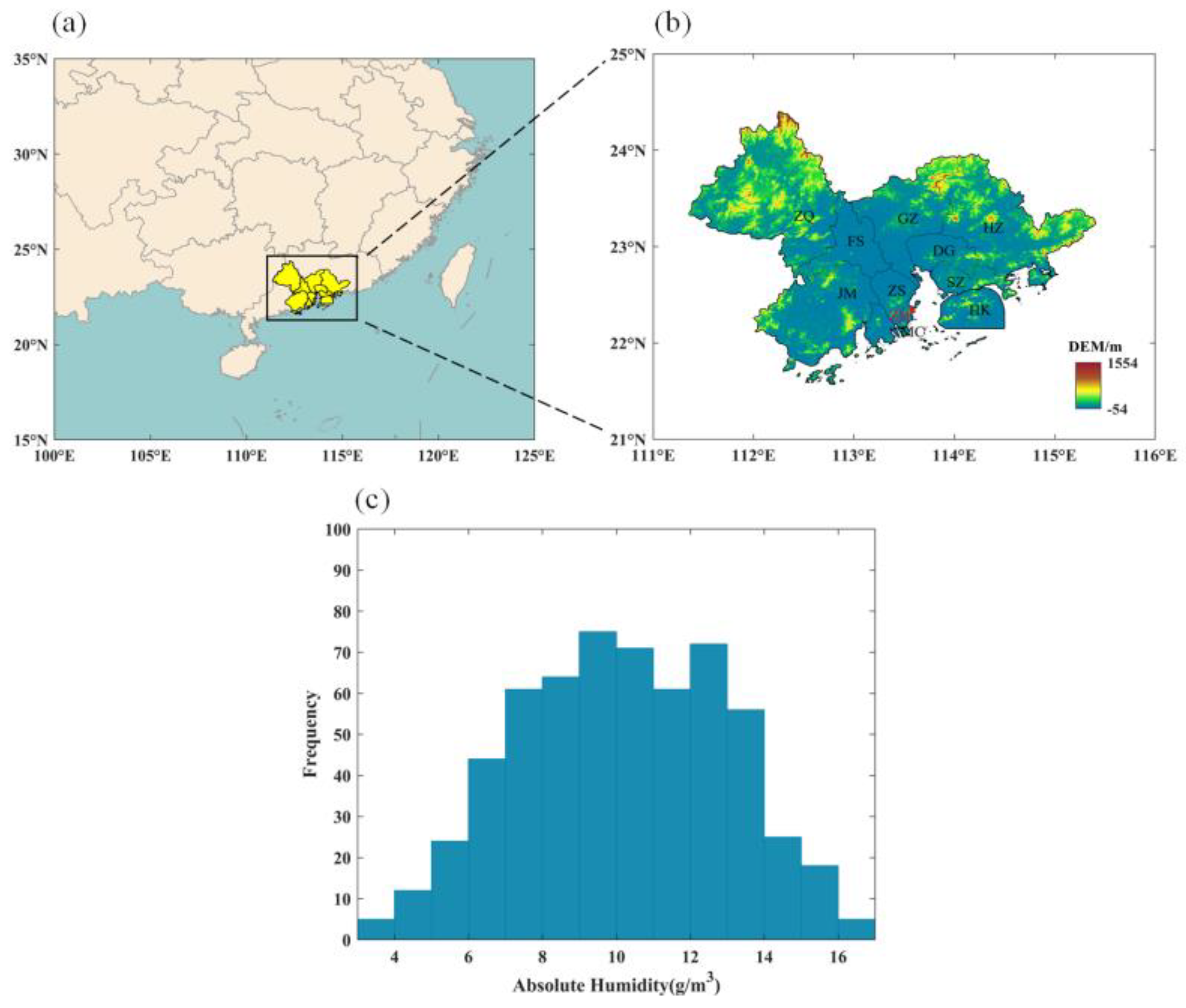
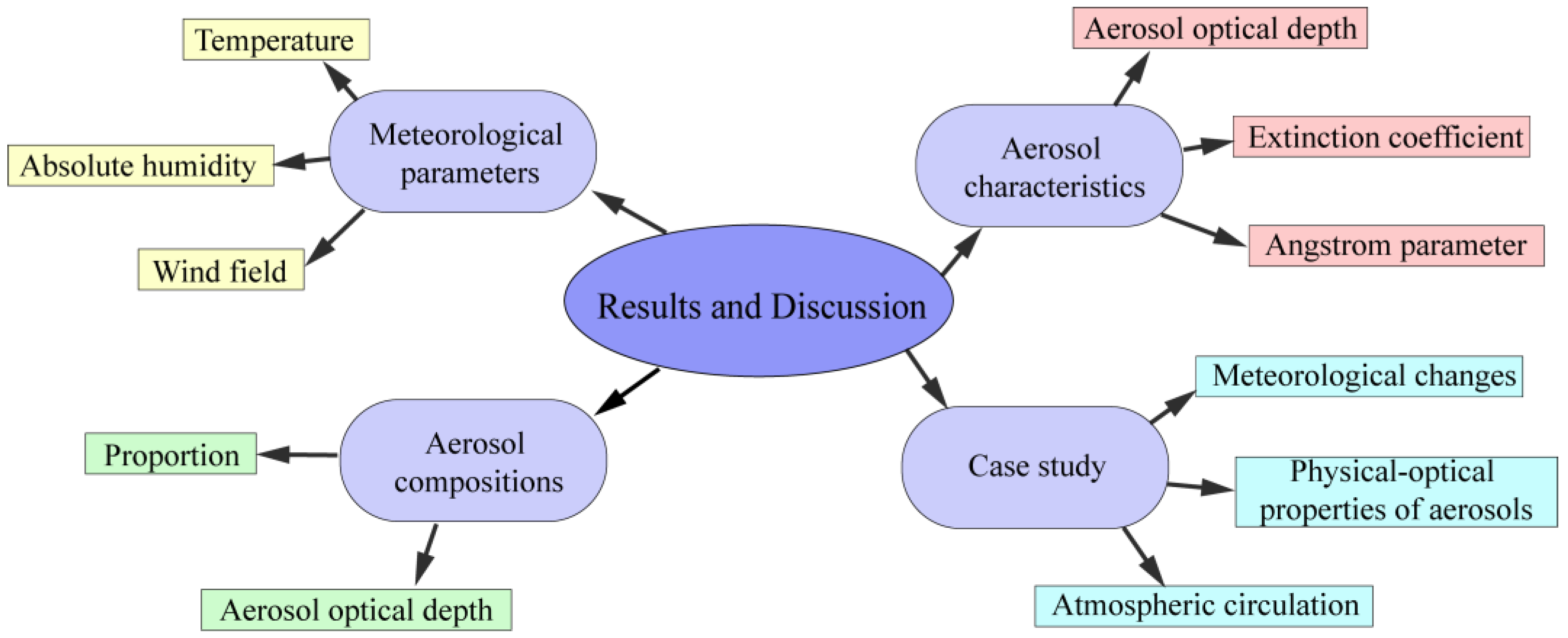
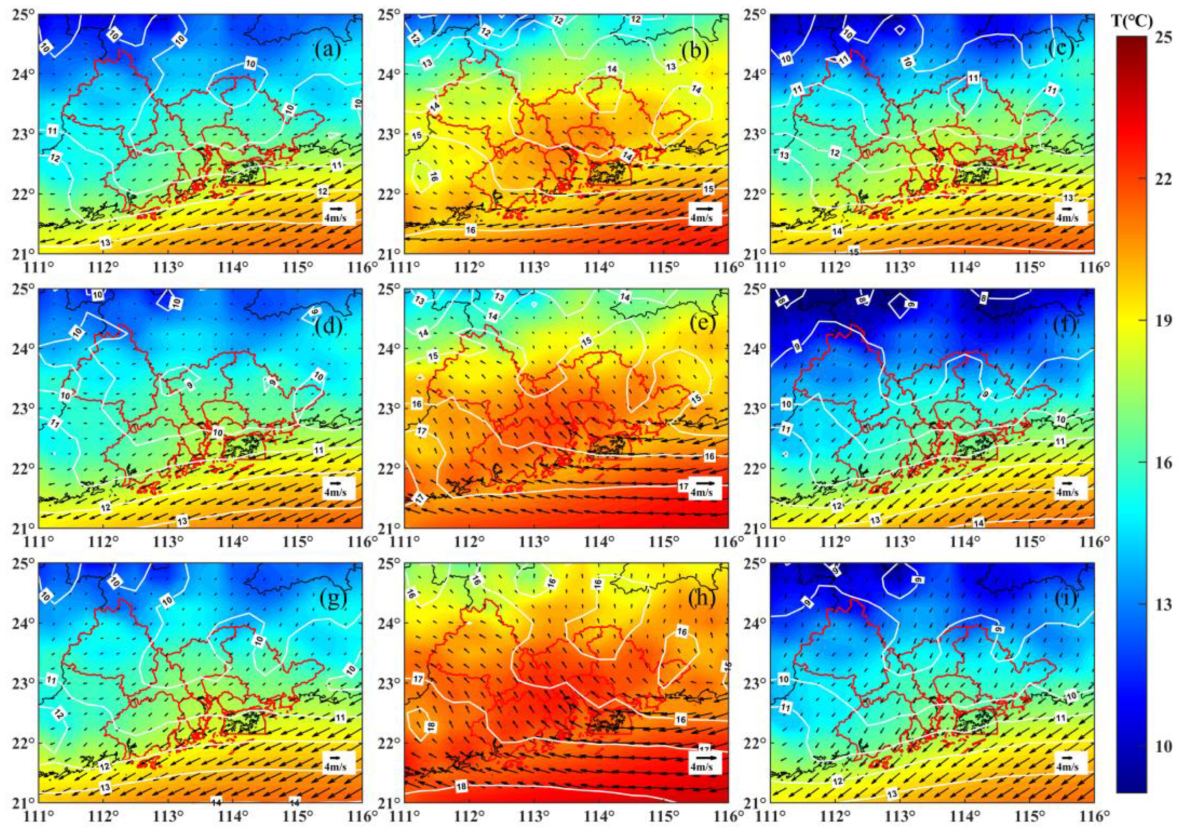
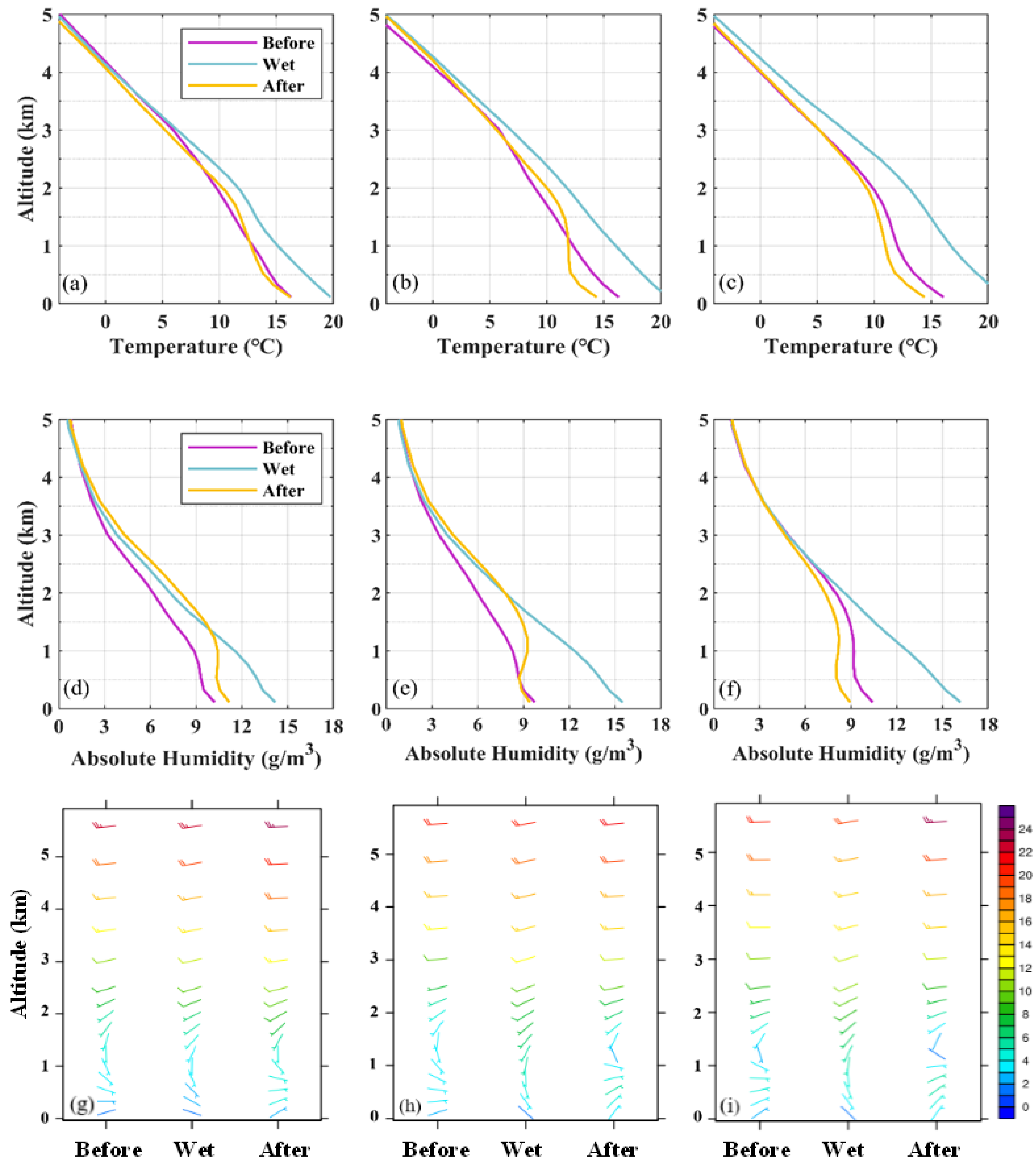
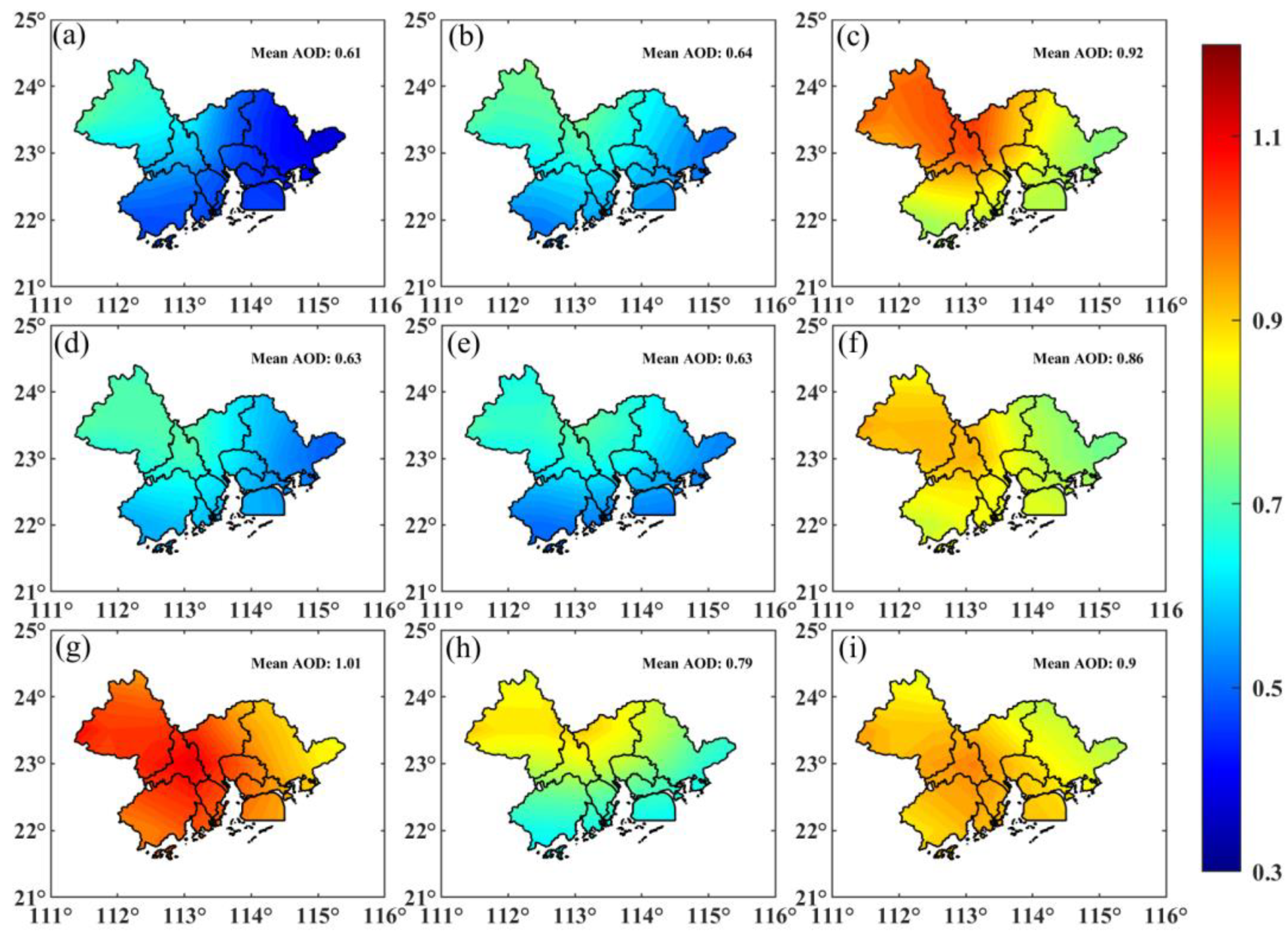
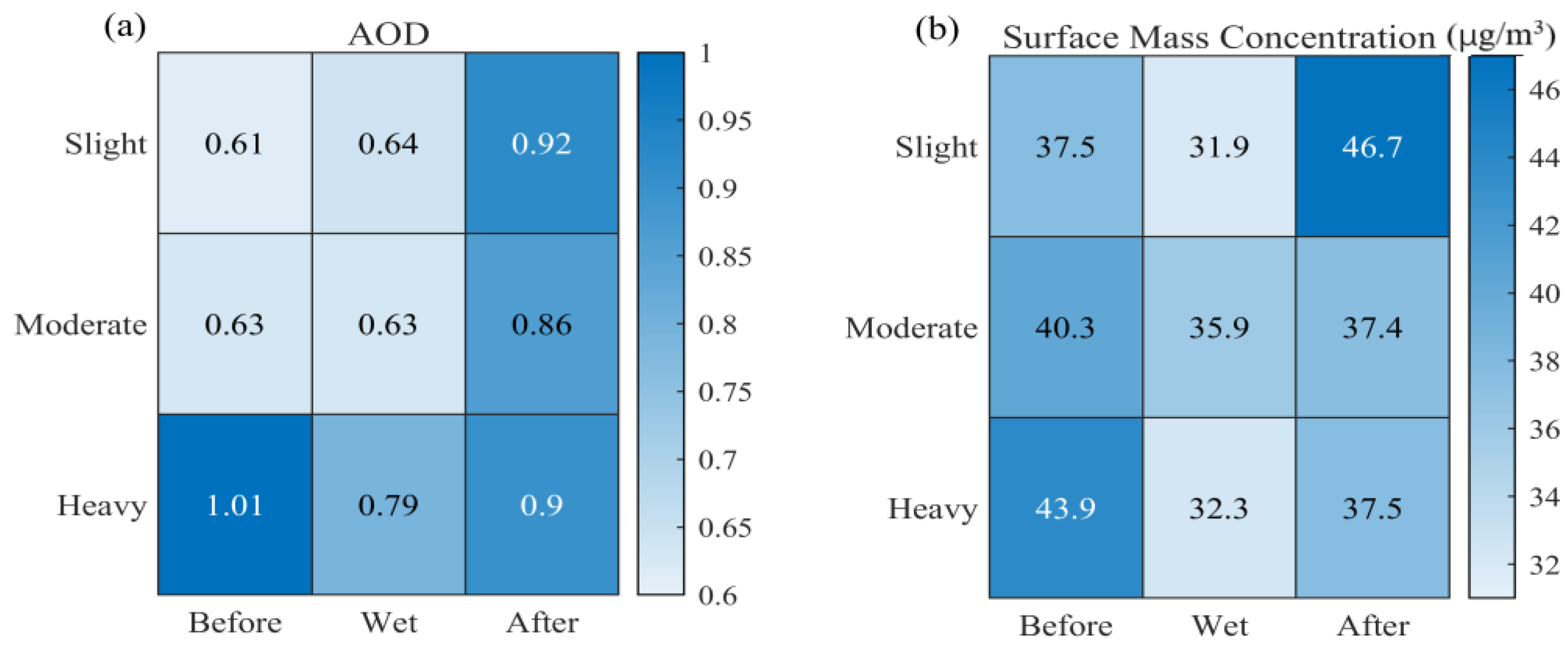
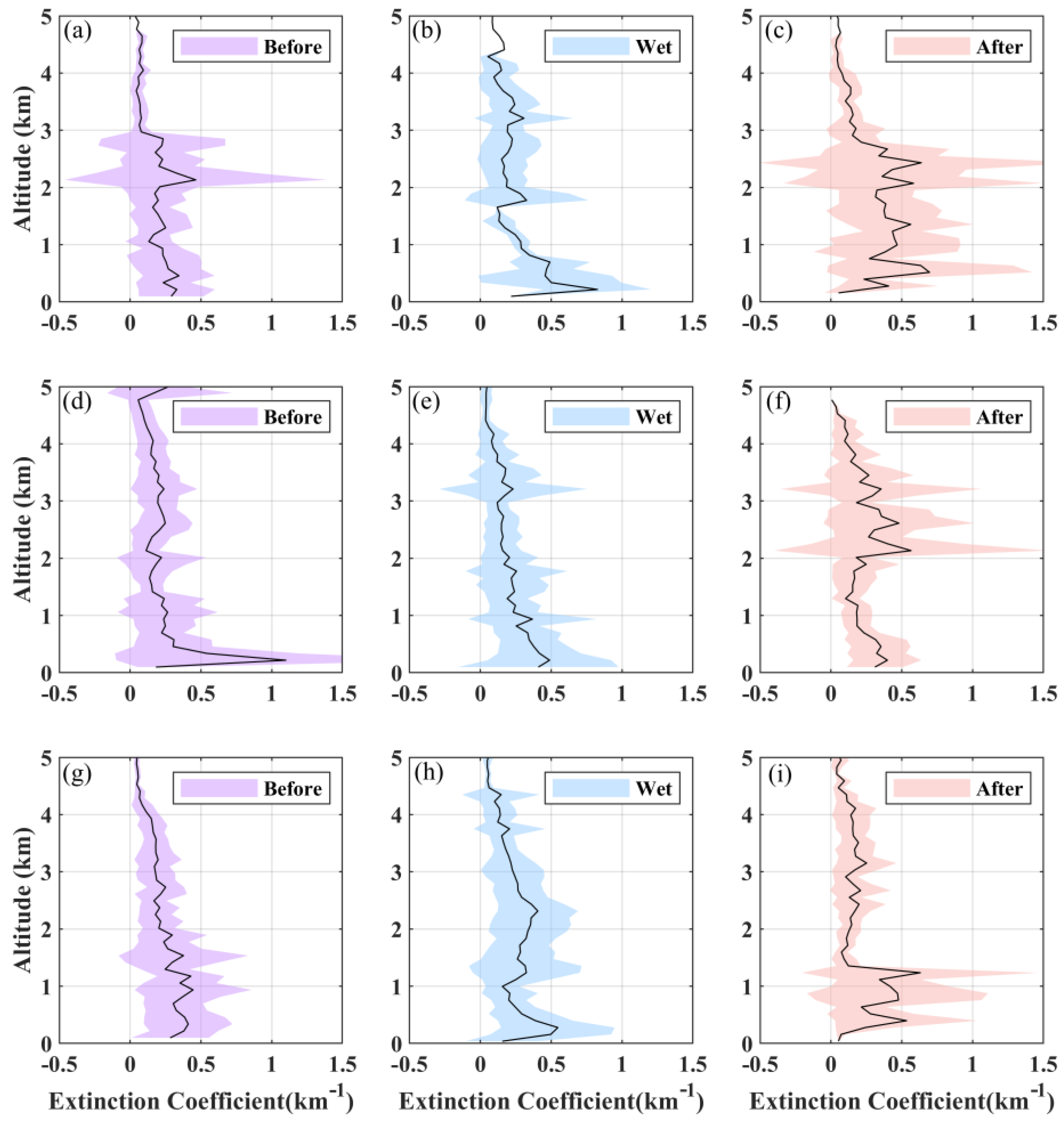
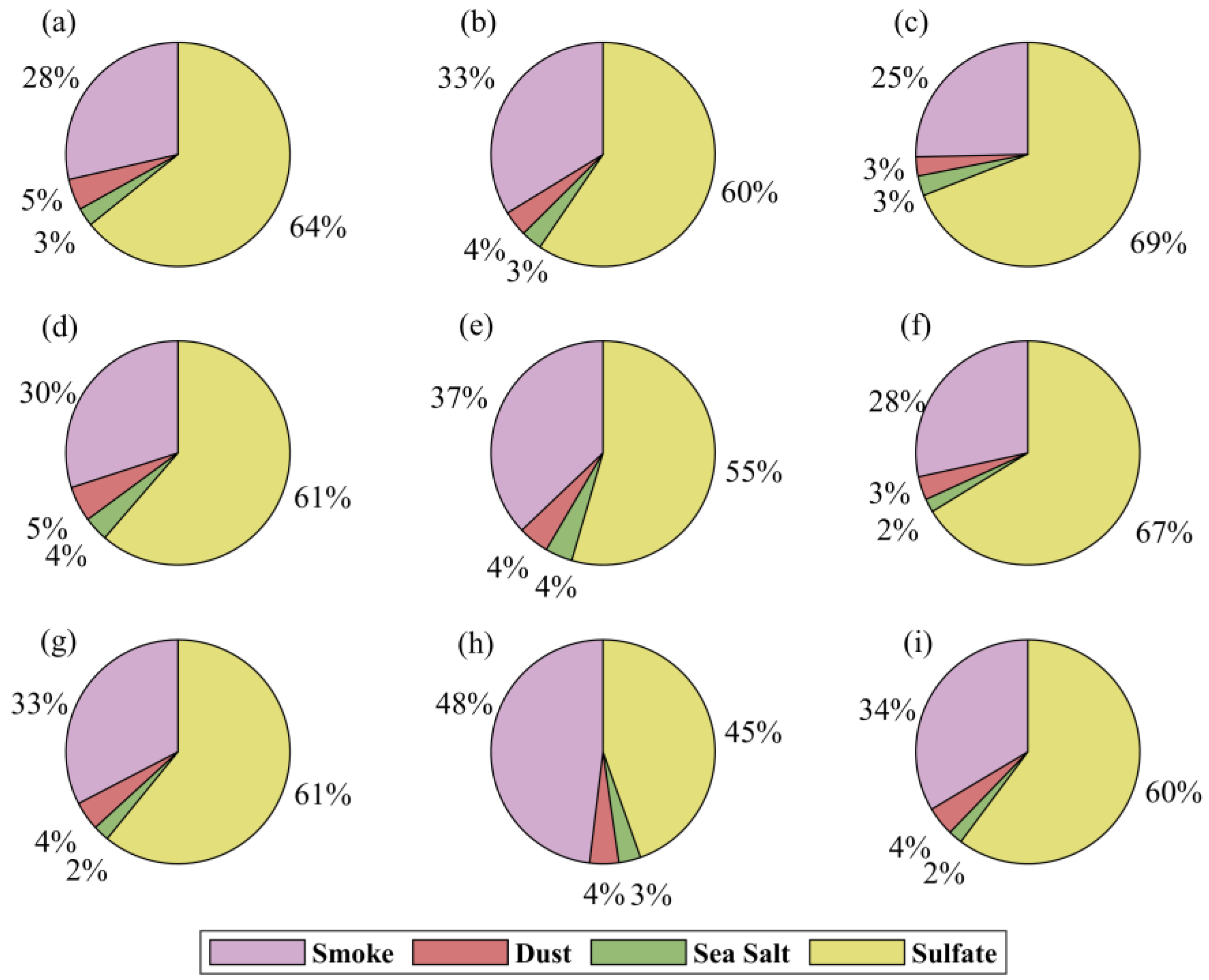
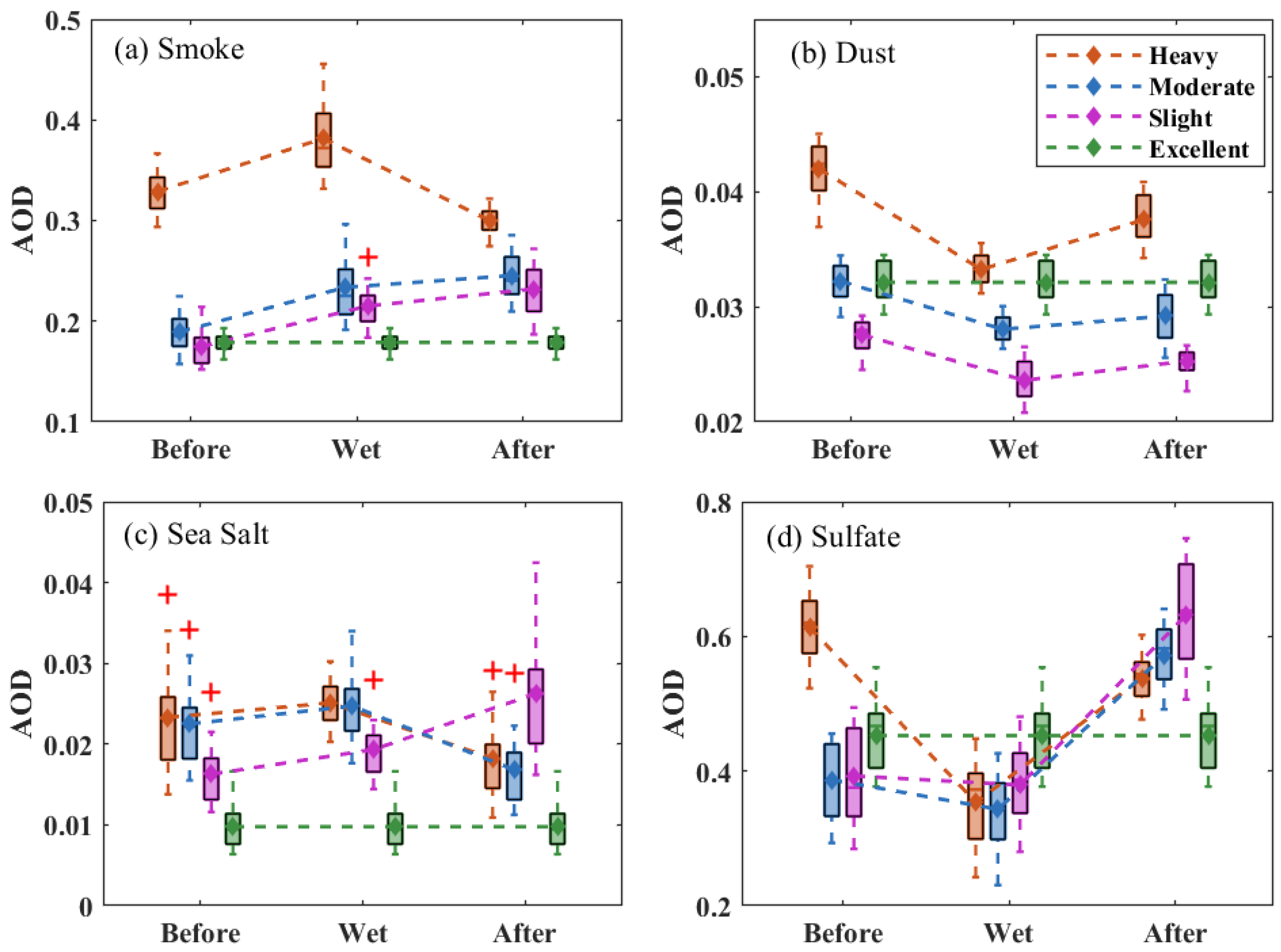
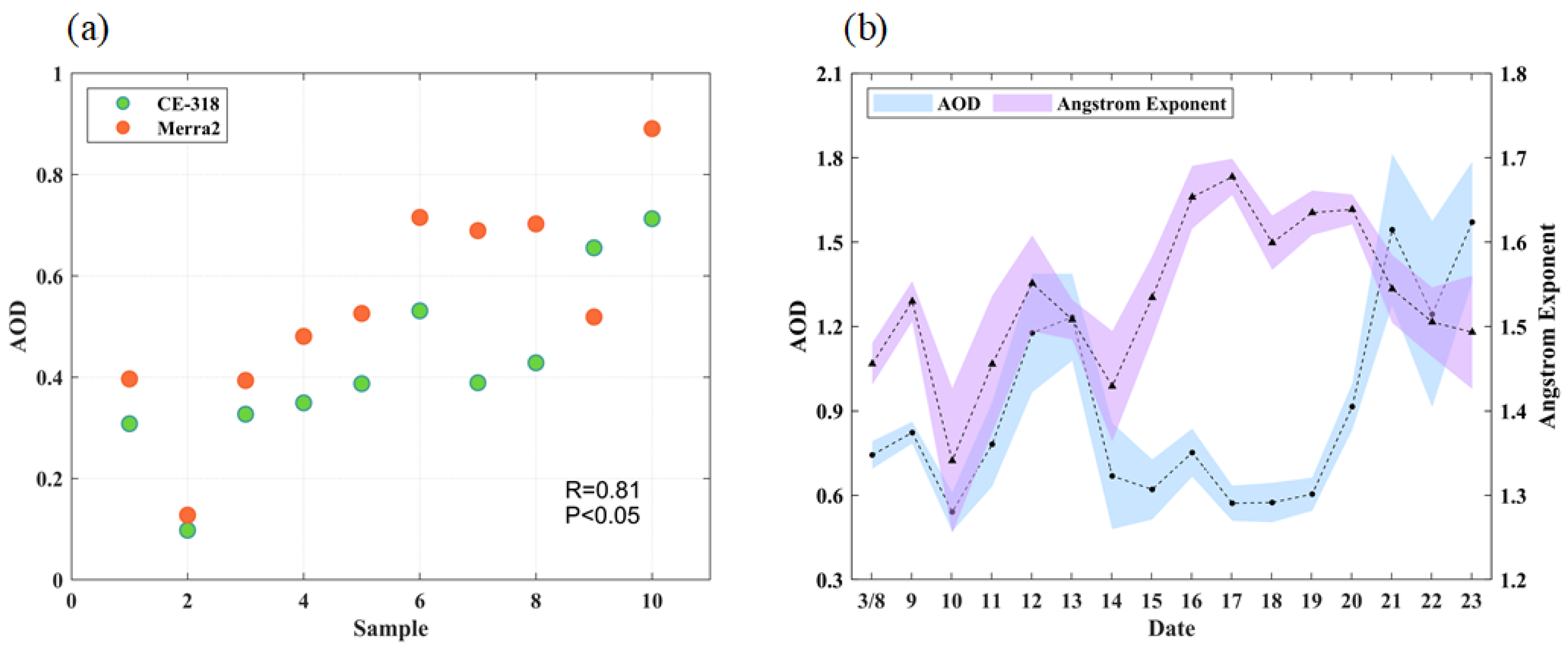
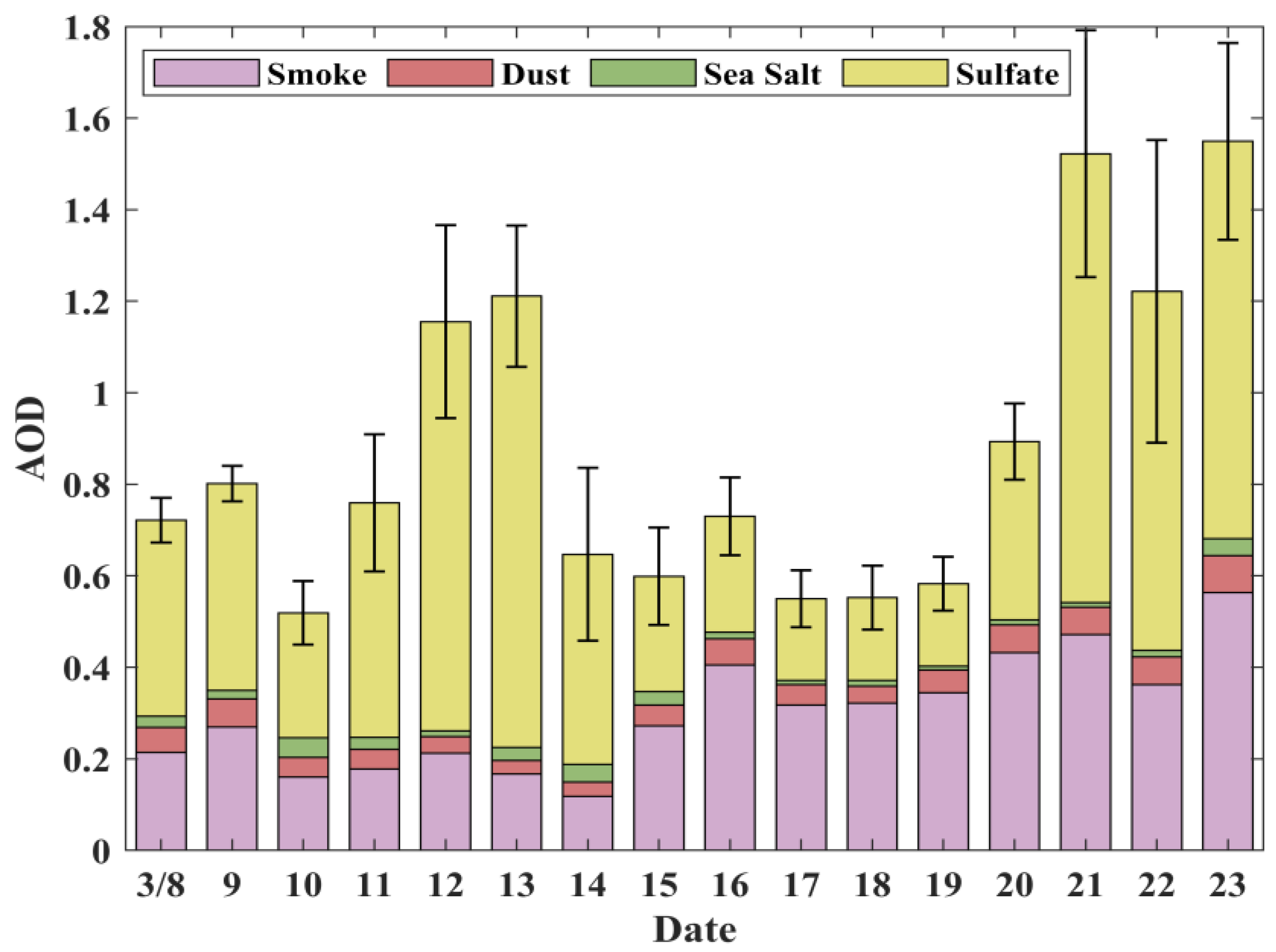
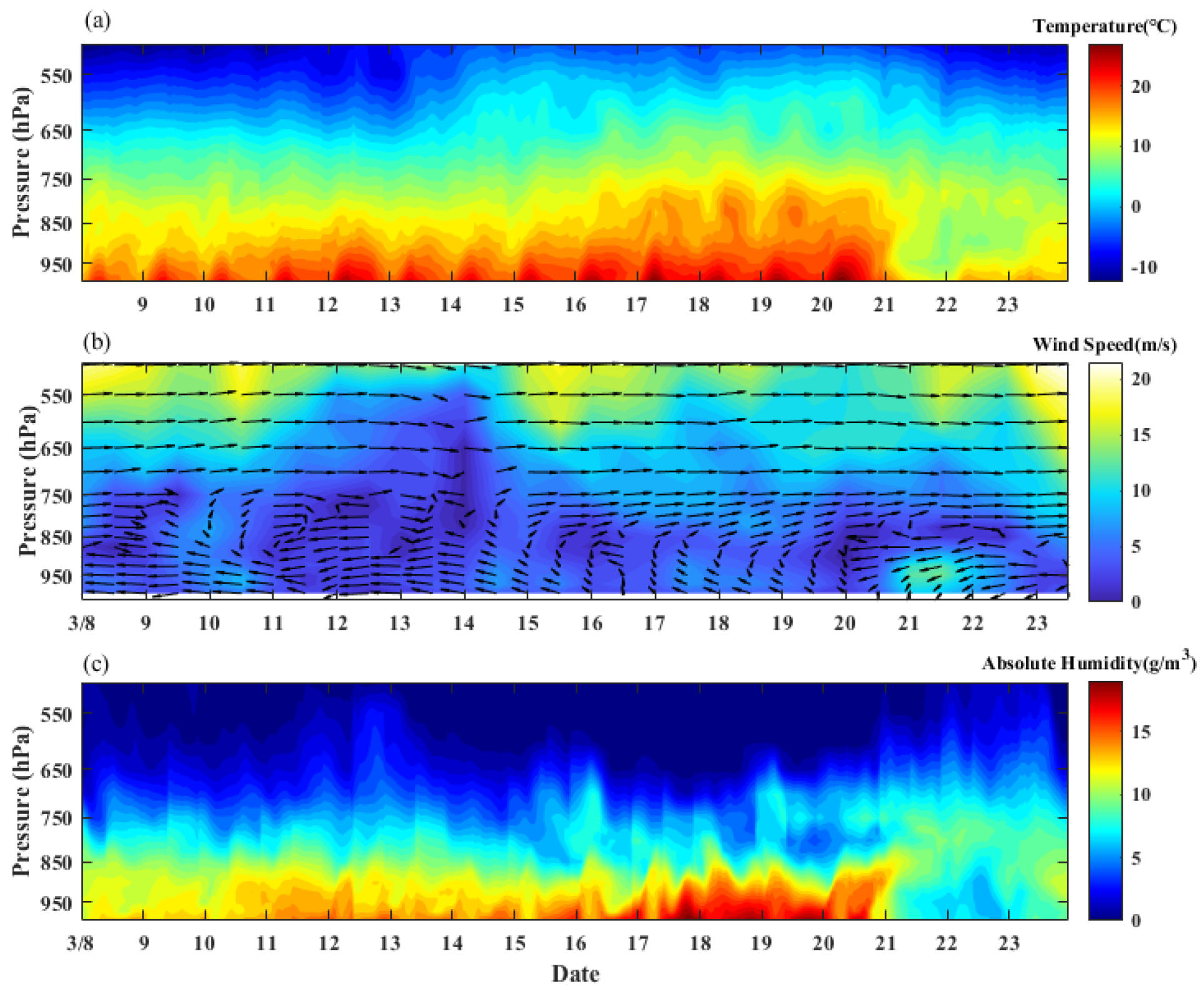
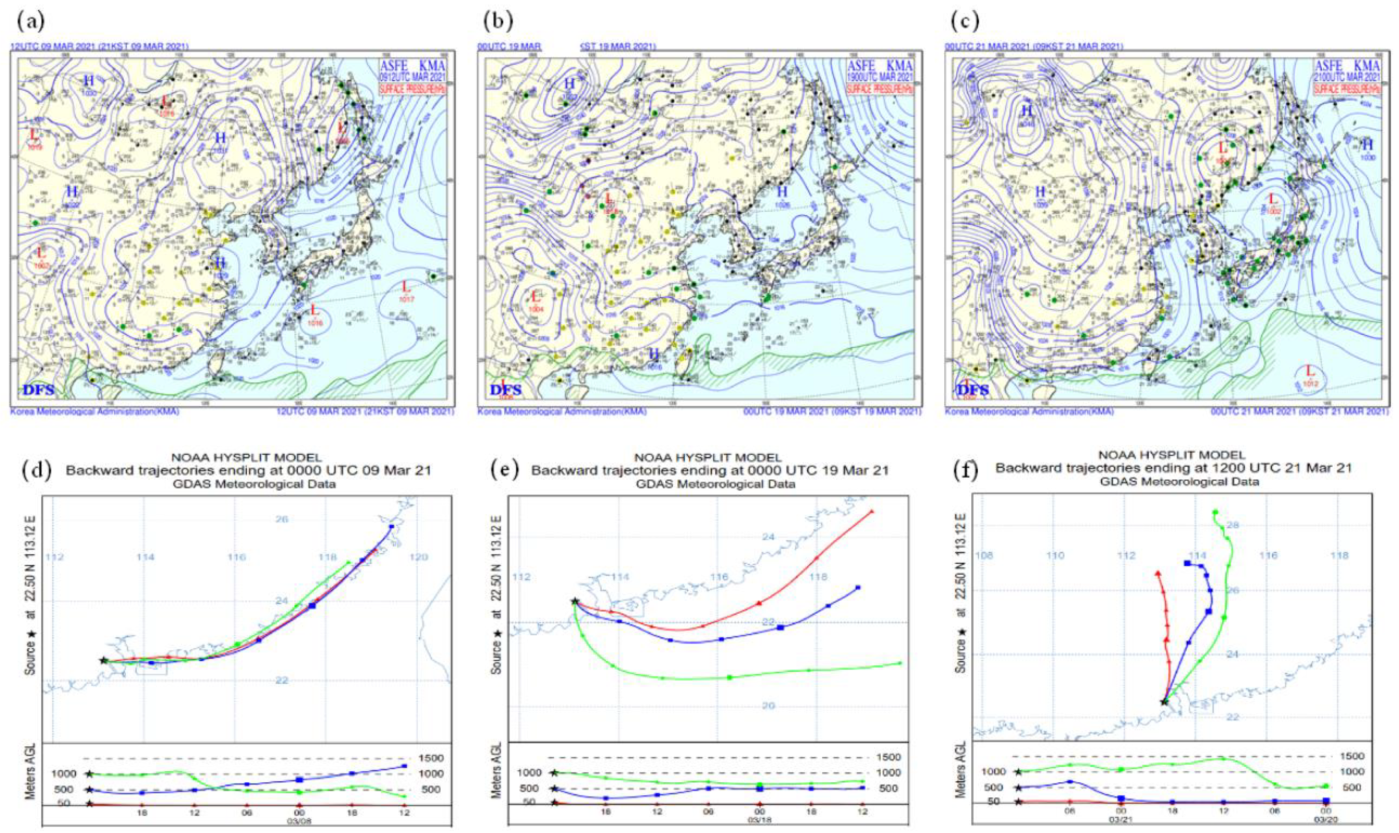
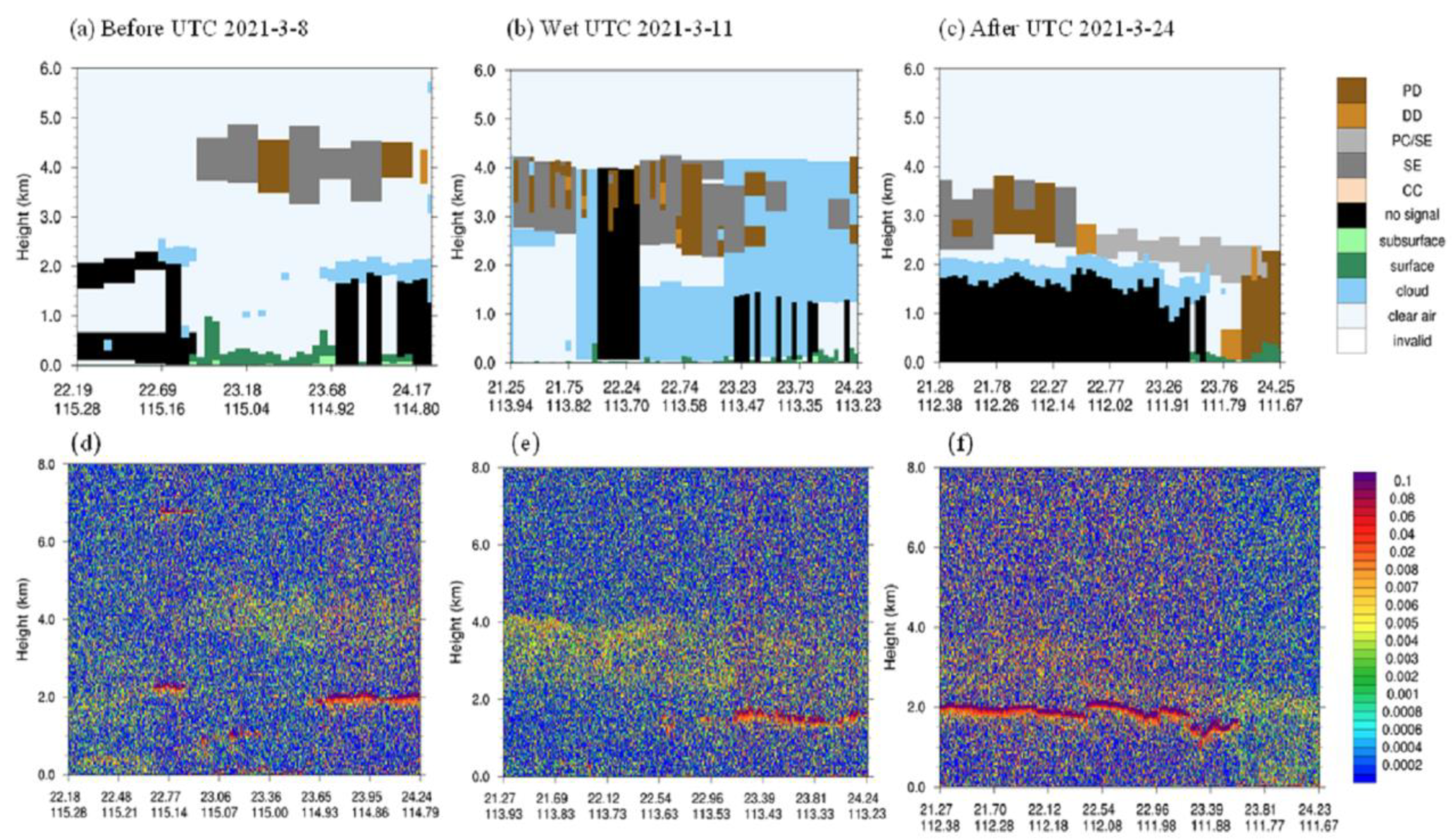
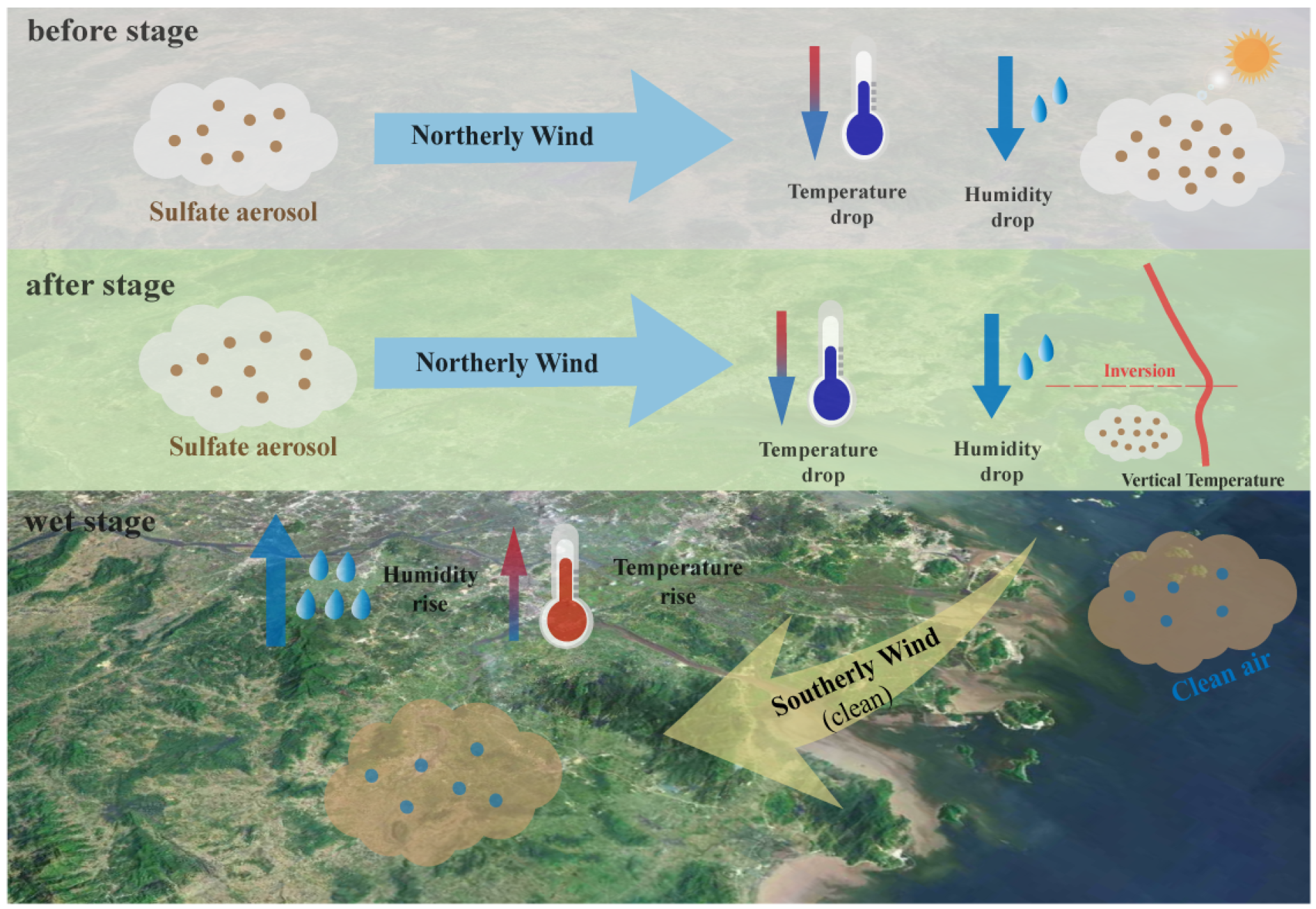
| Humidity Level | Excellent | Slight | Moderate | Heavy |
|---|---|---|---|---|
| Absolute Humidity(g/m3) | 3.5~6.5 | 11~12.4 | 12.4~13.7 | 13.7~16.9 |
| Samples | 16 | 12 | 20 | 20 |
| Duration(day) | 4 | 9 | 10 | 13 |
| Humidity Level | Temperature (°C) | Absolute Humidity (g/m3) | Relative Humidity (%) | Wind Speed (m/s) | Pressure (hPa) | Boundary Layer Height (m) | |
|---|---|---|---|---|---|---|---|
| Excellent | 14.6 | 9.1 | 51.7 | 2.6 | 1005.4 | 865 | |
| Slight | Before | 15.9 | 12.8 | 73.7 | 2.4 | 1002.8 | 790 |
| Wet | 19.6 | 14.2 | 83.2 | 1.8 | 1000.6 | 691 | |
| After | 16.6 | 11 | 80.8 | 2.6 | 1002.7 | 638 | |
| Moderate | Before | 16.3 | 9.8 | 70.1 | 2.1 | 1004.8 | 673 |
| Wet | 20.6 | 15.5 | 86.3 | 1.8 | 999.4 | 857 | |
| After | 15.0 | 9.6 | 76.3 | 2.8 | 1004.5 | 656 | |
| Heavy | Before | 16.4 | 10.4 | 76.1 | 2.3 | 1005.2 | 754 |
| Wet | 21.5 | 16.2 | 86 | 2.0 | 999.0 | 679 | |
| After | 15.1 | 9.3 | 73.1 | 2.8 | 1005.3 | 772 | |
Disclaimer/Publisher’s Note: The statements, opinions and data contained in all publications are solely those of the individual author(s) and contributor(s) and not of MDPI and/or the editor(s). MDPI and/or the editor(s) disclaim responsibility for any injury to people or property resulting from any ideas, methods, instructions or products referred to in the content. |
© 2023 by the authors. Licensee MDPI, Basel, Switzerland. This article is an open access article distributed under the terms and conditions of the Creative Commons Attribution (CC BY) license (https://creativecommons.org/licenses/by/4.0/).
Share and Cite
Zhao, Y.; Ding, J.; Han, Y.; Lu, T.; Zhang, Y.; Luo, H. Aerosol Physical–Optical Properties under Different Stages of Continuous Wet Weather over the Guangdong–Hong Kong–Macao Greater Bay Area, China. Remote Sens. 2023, 15, 1413. https://doi.org/10.3390/rs15051413
Zhao Y, Ding J, Han Y, Lu T, Zhang Y, Luo H. Aerosol Physical–Optical Properties under Different Stages of Continuous Wet Weather over the Guangdong–Hong Kong–Macao Greater Bay Area, China. Remote Sensing. 2023; 15(5):1413. https://doi.org/10.3390/rs15051413
Chicago/Turabian StyleZhao, Yuefeng, Jinxin Ding, Yong Han, Tianwei Lu, Yurong Zhang, and Hao Luo. 2023. "Aerosol Physical–Optical Properties under Different Stages of Continuous Wet Weather over the Guangdong–Hong Kong–Macao Greater Bay Area, China" Remote Sensing 15, no. 5: 1413. https://doi.org/10.3390/rs15051413
APA StyleZhao, Y., Ding, J., Han, Y., Lu, T., Zhang, Y., & Luo, H. (2023). Aerosol Physical–Optical Properties under Different Stages of Continuous Wet Weather over the Guangdong–Hong Kong–Macao Greater Bay Area, China. Remote Sensing, 15(5), 1413. https://doi.org/10.3390/rs15051413






